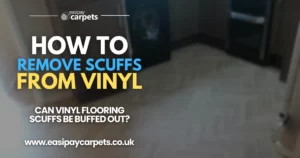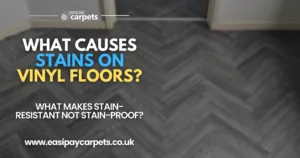

Struggling With Stains In Vinyl Flooring? Here's Our Top Tips!
Vinyl flooring is a popular choice for many homes due to its durability, affordability, and stylish appearance. However, like any flooring, it can become stained over time. Whether it’s from spills, scuffs, or everyday wear and tear, stains can detract from the appearance of your beautiful floors. Fortunately, with the right techniques and products, you can remove vinyl flooring stains effectively and keep your floors looking as good as new.
General Clean Tips For Vinyl Flooring
How Does Vinyl Flooring Work?
Before diving into stain removal techniques, it’s essential to understand the nature of vinyl flooring. Vinyl is a synthetic material made from polyvinyl chloride (PVC), which is known for its water-resistant properties. This makes it a popular choice for kitchens, bathrooms, and other high-moisture areas. However, vinyl can still be susceptible to stains, particularly from certain substances like dyes, oils, and strong acids.
General Tips For Cleaning Vinyl Floors
Before tackling specific stains, there are some general cleaning practices that can help maintain your vinyl floors:
- Regular Sweeping and Vacuuming: Dirt and debris can scratch the surface of vinyl, making it more susceptible to stains. Regularly sweeping or vacuuming your floors can help prevent this.
- Mop with a Gentle Cleaner: Use a damp mop with a mild cleaning solution designed for vinyl floors. Avoid using too much water, as excessive moisture can seep into the seams and cause damage.
- Avoid Harsh Chemicals: Abrasive cleaners, bleach, and ammonia-based products can damage vinyl flooring. Stick to pH-neutral cleaners or solutions specifically formulated for vinyl.
Removing Stains From Vinyl Flooring
Now, let’s explore some of the most effective methods to remove vinyl flooring stains. Depending on the type of stain, you may need to try different techniques.
1. Removing Water-Based Stains
Water-based stains, such as juice or wine, are among the easiest to remove. Here’s how:
-
Step 1: Blot the stain immediately with a clean cloth or paper towel to absorb as much of the liquid as possible.
-
Step 2: Mix a solution of warm water and a few drops of dish soap. Use a soft cloth or sponge to gently scrub the stained area.
-
Step 3: Rinse the area with clean water and dry it thoroughly with a towel to prevent moisture from seeping into the seams.
2. Removing Oil-Based Stains
Oil-based stains, like those from cooking oils or makeup, can be a bit more challenging but are still manageable.
-
Step 1: Sprinkle some baking soda over the stain to help absorb the oil.
-
Step 2: After a few minutes, use a soft cloth to wipe away the baking soda. If the stain persists, apply a small amount of isopropyl alcohol to a cloth and gently rub the stain.
-
Step 3: Rinse the area with water and dry it thoroughly.
3. Removing Scuff Marks
Scuff marks from shoes or furniture are common on vinyl floors. Here’s how to remove them:
-
Step 1: Use a pencil eraser to rub away the scuff mark. This method works well for light scuffs.
-
Step 2: For more stubborn marks, use a melamine foam sponge (like a Magic Eraser). Dampen the sponge and gently rub the scuff until it disappears.
-
Step 3: Rinse and dry the area as usual.
4. Removing Ink and Dye Stains
Ink and dye stains can be particularly stubborn. Here’s a method to tackle them:
-
Step 1: Dampen a cloth with rubbing alcohol and gently dab the stain. Avoid rubbing too hard, as this can damage the vinyl.
-
Step 2: If the stain persists, try using a small amount of nail polish remover (acetone). Test it in an inconspicuous area first to ensure it doesn’t damage the vinyl.
-
Step 3: Rinse thoroughly with water and dry the area.
5. Dealing with Tough Stains
For particularly tough stains, such as those from rust or permanent marker, you may need to use a commercial vinyl floor cleaner or stain remover. Follow the instructions on the product carefully, and always test it on a small area first.
Preventing Future Stains
Prevention is always better than cure. Here are some tips to help prevent stains on your vinyl flooring:
-
Use Doormats: Place doormats at entryways to trap dirt and moisture before they reach your floors.
-
Wipe Spills Immediately: Quick action can prevent spills from turning into stubborn stains.
-
Protect High-Traffic Areas: Consider using rugs or runners in high-traffic areas to protect your floors.
-
Avoid Dragging Furniture: Use furniture pads or lift furniture when moving it to avoid scuffing your floors.
Vinyl Floor Maintenance Tips
Maintaining your vinyl flooring can extend its life and keep it looking pristine:
-
Regular Cleaning: Stick to a regular cleaning schedule to prevent dirt and grime from building up.
-
Use the Right Products: Always use cleaning products that are safe for vinyl. Avoid harsh chemicals and abrasive tools.
-
Re-sealing: Some vinyl floors may benefit from a re-seal every few years to protect the surface and enhance its stain resistance.
Conclusion
Vinyl flooring is a fantastic choice for any home, offering a blend of durability, affordability, and style. However, like all flooring, it requires care and attention to keep it looking its best. By following the tips and techniques outlined in this guide, you can effectively remove vinyl flooring stains and maintain your floors for years to come.
Remember, regular maintenance and prompt action when spills occur are the keys to keeping your vinyl floors in top condition.
Further Reading
For those of you who love diving deep into home improvement and flooring tips, here are some fantastic resources:
We hope this guide helps you maintain that brand new looking vinyl flooring for many years to come!
Easipay Carpets can help you get brand new flooring without the high up-front cost – by simply letting you spread the cost of the flooring over time instead. There’s no interest on our plans so you aren’t spending a penny more than you would buying it outright and we include underlay, door trims, carpet grippers and laminate beading for free. Prices start from just £10 per week!
It starts with a free home appointment and quote, to get booked in at a time that suits you, tap the “Get Started” button below and fill out the contact form!
Still Got Questions? Here's 10 FAQs!
It’s best to avoid bleach on vinyl flooring as it can discolour the material and cause damage. Stick to milder cleaning solutions.
Regular sweeping or vacuuming should be done weekly, with mopping as needed depending on traffic and spills.
If water gets under your vinyl flooring, it’s essential to dry the area as quickly as possible to prevent mould and damage. If necessary, contact a professional.
It’s generally not recommended to use a steam mop on vinyl floors, as the heat and moisture can damage the adhesive and cause the vinyl to warp.
Use a small amount of mineral spirits or a commercial adhesive remover. Test in an inconspicuous area first and clean up any residue immediately.
Blot the stain, clean with a mixture of vinegar and water, and rinse thoroughly. For odour, sprinkle baking soda and vacuum it up after a few hours.
Vinyl flooring cannot be refinished like hardwood, but applying a vinyl sealer can help restore some shine and protect the surface.
Peeling vinyl flooring can often be re-glued with a vinyl adhesive. If the peeling is extensive, consider consulting a professional for repairs.
Yes, a solution of vinegar and water is an eco-friendly and effective cleaner for vinyl floors. Baking soda can also be used for stain removal.
Yes, prolonged exposure to direct sunlight can cause vinyl to fade. Use curtains or blinds to protect your flooring from excessive sunlight.




